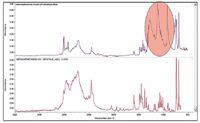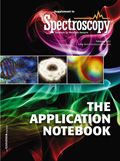Using Multi-Component Search for More Effective Identification of Seized Drugs by FT-IR
Infrared analysis of seized drugs is underutilized in many forensic laboratories owing to the ambiguous results produced by samples containing a mixture of compounds. The use of a patented multi-component search algorithm can help overcome the limitations of infrared for the identification of drugs in mixture samples.
Mike Garry, Thermo Fisher Scientific
Infrared analysis of seized drugs is underutilized in many forensic laboratories owing to the ambiguous results produced by samples containing a mixture of compounds. The use of a patented multi-component search algorithm can help overcome the limitations of infrared for the identification of drugs in mixture samples.
A basic need of a law enforcement agency is to positively identify controlled substances in seized drug samples to support legal proceedings and get convictions (Figure 1). Since 1997, the Scientific Working Group for the Analysis of Seized Drugs (SWGDRUG) has been providing recommendations for the analysis of drugs. Recent changes to the wording in the 5th Edition of the SWGDRUG recommendations published in January 2010 impacted forensic scientists in respect to the use of data from analytical techniques for drug identification.

Figure 1: Seized drug identification supports legal proceedings.
According to the SWGDRUG recommendations, identification techniques with the highest discriminating power should preferentially be used for drug identification. Techniques having the highest discriminating power include infrared, mass spectrometry, NMR, Raman, and X-ray diffraction. Concerning these techniques, the thrust of the changes in the 5th Edition SWGDRUG recommendations relate to the potential reduction in discriminating power for a technique based on the sample, analyte, or mode of operation.
For infrared spectroscopy it specifically states that a mixture sample that produces a spectrum combining more than one chemical entity may not provide definitive drug identification. The patented Multi-Component Search algorithm (U.S. 7698098) in Thermo Scientific OMNIC Specta software can overcome this limitation and help forensic scientists more effectively use infrared analysis to aid identification of drug mixtures.
Experimental
In modern FT-IR spectrometers a single-bounce diamond ATR sampling device is most often used for quick analysis and unknown identification. The entire sample analysis step is typically complete in 30 s, making FT-IR a rapid screening technique. For this study a seized street drug sample was run on a Thermo Scientific Fourier-transform infrared spectrometer (FT-IR) (Figure 2) using a Smart iTR single-bounce diamond crystal. It is important to note that since less than a milligram of sample is needed for analysis, the sample placed on the crystal must be representative of the entire sample.

Figure 2: Rapid analysis of powders using a diamond ATR accessory.
Results
Once the spectrum of the sample was obtained the most common approach for infrared identification was applied, involving a simple search to compare the unknown sample against drug references library. The simple search assumes the unknown spectrum represents a single material or that the library has spectra representative of the components found in the sample. The search found methamphetamine. However, since the sample was a mixture, many additional peaks were present in the sample spectrum compared to the library reference (Figure 3). This "combined spectrum" scenario is exactly what drove updates to the 5th Edition SWGDRUG recommendations related to the "diminished discriminating power" of the infrared technique. In this case the sample (a mixture) and mode of operation (simple search) produced a result not visually definitive, even though it may be obvious to a trained observer that this sample contains methamphetamine.

Figure 3: Unexplained peaks in the sample spectrum can diminish the discriminating power of the infrared technique.
Next, spectral subtraction was used to account for the additional peaks. The subtraction result allowed a second component to be identified as dimethyl sulfone, a common cutting agent for methamphetamine. Although this mathematical "clean up" led to an improved search metric for methamphetamine, it is subjective and takes a trained eye to determine the best subtraction factor. It also leads to spectral distortions in the result spectrum and can be viewed as "data manipulation," lowering confidence in the results and making them more difficult to defend in court.
Finally, the OMNIC™ Specta Multi-Component Search feature was used to identify the mixture in a single step without operator intervention. The extra processing time, data manipulation, and spectral distortions of the spectral subtraction step were eliminated providing much less subjective results and higher confidence for the operator. The graphical display of the results (Figure 4) shows the unknown mixture spectrum at the top with the composite spectrum directly below it and the library reference spectra at the bottom. The composite spectrum is generated automatically by Multi-Component Search from the two library spectra, dimethyl sulfone and methamphetamine, and represents the mathematical combination of the library spectra which provide the best match for the unknown sample spectrum. This graphical output combined with the non-subjective generation of results provides high confidence in the result and a much more compelling argument in court.

Figure 4: Multi-Component Search generates the combination of reference spectra that best match the unknown.
Conclusion
The SWGDRUG 5th Edition recommendations increase expectations for seized drug identification including the potential reduction in discriminating power of infrared spectroscopy used with mixture samples. The optimized process using FT-IR with a single-bounce diamond ATR combined with Thermo Scientific OMNIC Specta Multi-Component Search allows the forensic analyst to rapidly screen seized drug samples and aids in their identification. This mixture searching capability can go a long way to improve the information the FT-IR generates, which is of key importance for improved court testimony associated with infrared results.
Thermo Fisher Scientific
5225-4 Verona Rd, Madison, WI 53711
tel. (800) 532-4752
Website: www.thermo.com

Measurement of Ammonia Leakage by TDLAS in Mid-Infrared Combined with an EMD-SG Filter Method
April 9th 2024In this article, tunable diode laser absorption spectroscopy (TDLAS) is used to measure ammonia leakage, where a new denoising method combining empirical mode decomposition with the Savitzky-Golay smoothing algorithm (EMD-SG) is proposed to improve the signal-to-noise ratio (SNR) of absorbance signals.